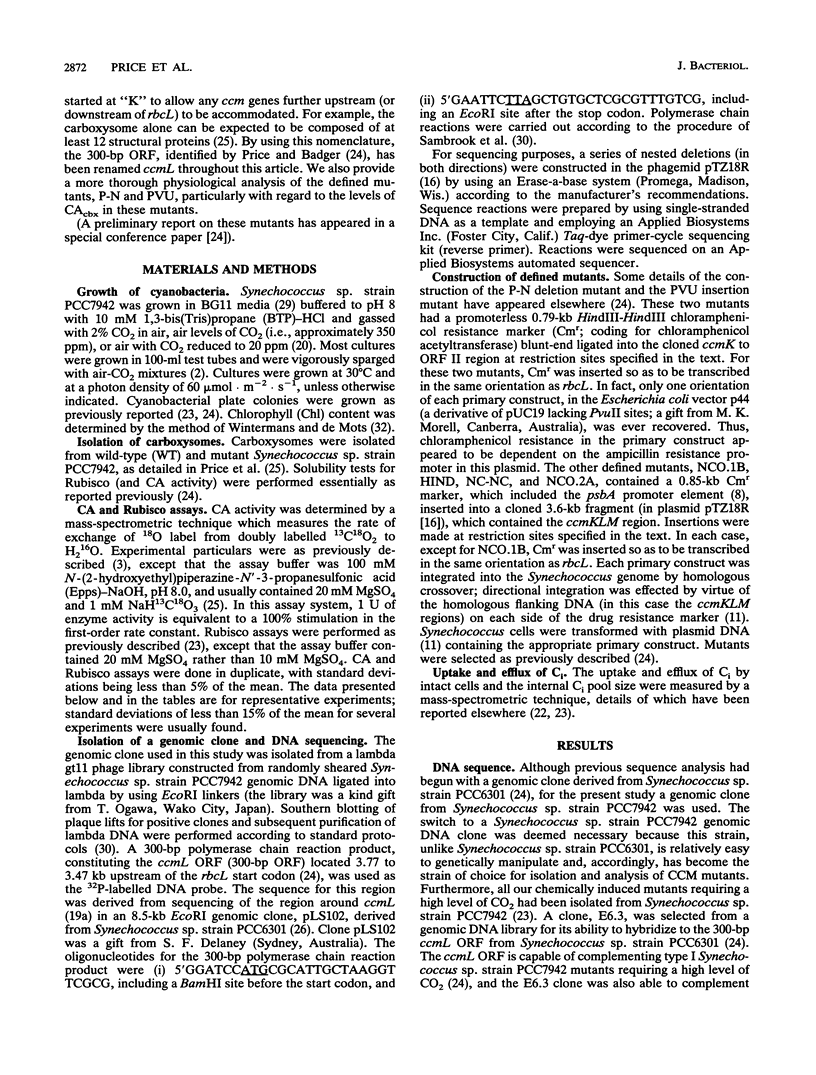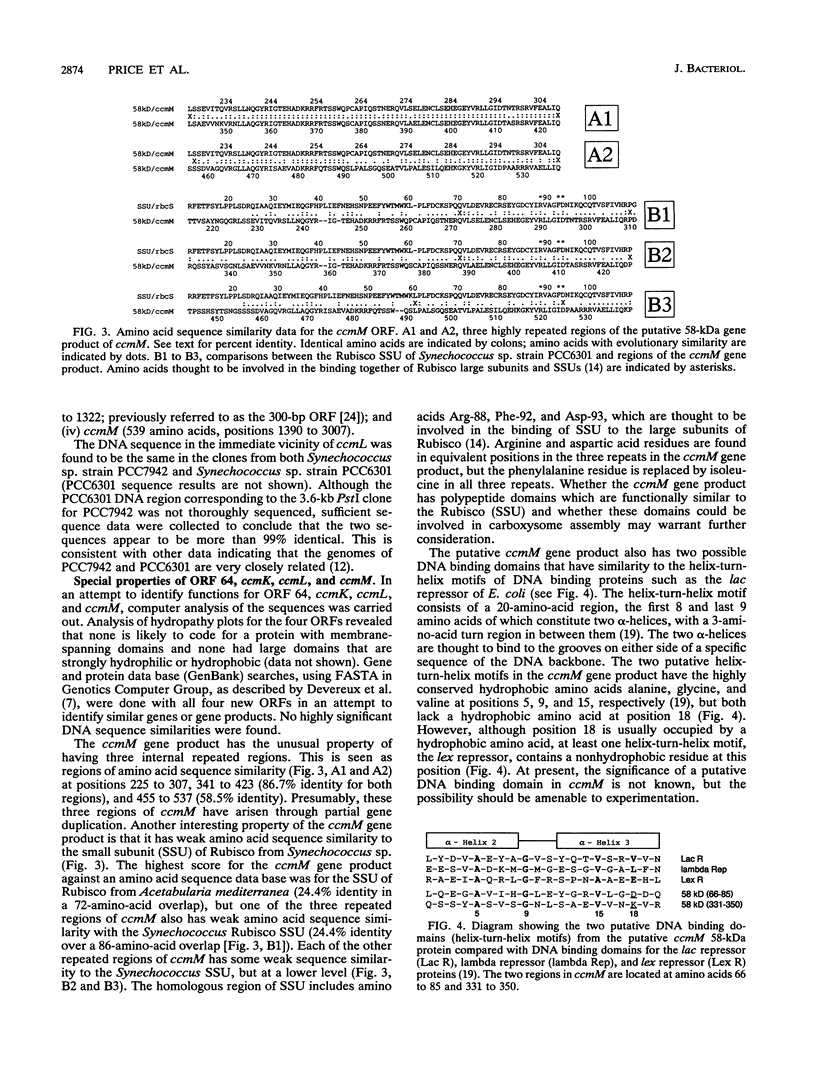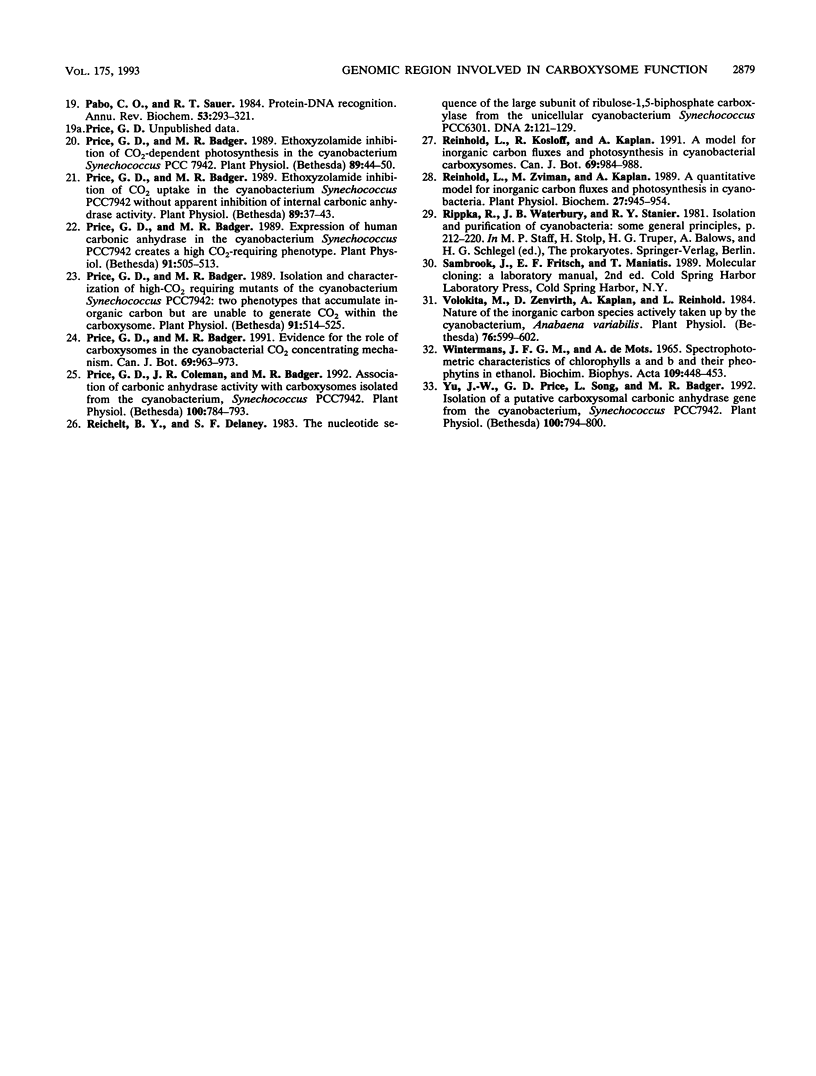Abstract
We report on the sequencing and analysis of a 3,557-bp genomic DNA clone that is located between 4.8 and 1.2 kilobase pairs (kb) upstream of the rbcL gene and is capable of complementing a class of cyanobacterium Synechococcus sp. strain PCC7942 mutants requiring a high level of CO2. The upstream 2,704 bp of this sequence is novel, the remaining 852 bp having been reported by other workers. Four new open reading frames (ORFs) have been identified along with putative promoter elements. These ORFs, which could code for proteins of 7, 10.9, 11, and 58 kDa in size, have been named ORF 64, ccmK, ccmL, and ccmM, respectively. The last three have been named ccm genes on the basis that insertional mutagenesis of each produces a phenotype requiring a high level of CO2 (i.e., each produces a lesion in the CO2 concentrating mechanism). The putative gene product for the large ccmM ORF has three internally repeated regions and also has two possible DNA binding motifs. Two defined mutants in the 3,557-bp region, mutants PVU and P-N, have been more fully characterized. The PVU mutant has a drug marker inserted into the ccmL gene, and it possesses abnormal rod-shaped carboxysomes. The P-N mutant is a 2.64-kb deletion of DNA from the same position in ccmL to a region closer to rbcL. This mutant, which has previously been shown to lack carboxysomes and have soluble ribulosebiphosphate carboxylase/oxygenase activity, has now been shown to have a predominantly soluble carboxysomal carbonic anhydrase activity. Both mutants were found to possess carboxysomal carbonic anhydrase activities which are below wild-type levels, and in the P-N mutant this activity appears to be unstable. The results are discussed in terms of the possible interactions of putative ccm gene products in the process of carboxysome assembly and function.
Full text
PDF








Images in this article
Selected References
These references are in PubMed. This may not be the complete list of references from this article.
- Badger M. R., Price G. D. Carbonic Anhydrase Activity Associated with the Cyanobacterium Synechococcus PCC7942. Plant Physiol. 1989 Jan;89(1):51–60. doi: 10.1104/pp.89.1.51. [DOI] [PMC free article] [PubMed] [Google Scholar]
- Devereux J., Haeberli P., Smithies O. A comprehensive set of sequence analysis programs for the VAX. Nucleic Acids Res. 1984 Jan 11;12(1 Pt 1):387–395. doi: 10.1093/nar/12.1part1.387. [DOI] [PMC free article] [PubMed] [Google Scholar]
- Dzelzkalns V. A., Owens G. C., Bogorad L. Chloroplast promoter driven expression of the chloramphenicol acetyl transferase gene in a cyanobacterium. Nucleic Acids Res. 1984 Dec 11;12(23):8917–8925. doi: 10.1093/nar/12.23.8917. [DOI] [PMC free article] [PubMed] [Google Scholar]
- Friedberg D., Kaplan A., Ariel R., Kessel M., Seijffers J. The 5'-flanking region of the gene encoding the large subunit of ribulose-1,5-bisphosphate carboxylase/oxygenase is crucial for growth of the cyanobacterium Synechococcus sp. strain PCC 7942 at the level of CO2 in air. J Bacteriol. 1989 Nov;171(11):6069–6076. doi: 10.1128/jb.171.11.6069-6076.1989. [DOI] [PMC free article] [PubMed] [Google Scholar]
- Fukuzawa H., Suzuki E., Komukai Y., Miyachi S. A gene homologous to chloroplast carbonic anhydrase (icfA) is essential to photosynthetic carbon dioxide fixation by Synechococcus PCC7942. Proc Natl Acad Sci U S A. 1992 May 15;89(10):4437–4441. doi: 10.1073/pnas.89.10.4437. [DOI] [PMC free article] [PubMed] [Google Scholar]
- Golden S. S., Brusslan J., Haselkorn R. Genetic engineering of the cyanobacterial chromosome. Methods Enzymol. 1987;153:215–231. doi: 10.1016/0076-6879(87)53055-5. [DOI] [PubMed] [Google Scholar]
- Golden S. S., Nalty M. S., Cho D. S. Genetic relationship of two highly studied Synechococcus strains designated Anacystis nidulans. J Bacteriol. 1989 Jan;171(1):24–29. doi: 10.1128/jb.171.1.24-29.1989. [DOI] [PMC free article] [PubMed] [Google Scholar]
- Hawley D. K., McClure W. R. Compilation and analysis of Escherichia coli promoter DNA sequences. Nucleic Acids Res. 1983 Apr 25;11(8):2237–2255. doi: 10.1093/nar/11.8.2237. [DOI] [PMC free article] [PubMed] [Google Scholar]
- Knight S., Andersson I., Brändén C. I. Crystallographic analysis of ribulose 1,5-bisphosphate carboxylase from spinach at 2.4 A resolution. Subunit interactions and active site. J Mol Biol. 1990 Sep 5;215(1):113–160. doi: 10.1016/S0022-2836(05)80100-7. [DOI] [PubMed] [Google Scholar]
- Mead D. A., Szczesna-Skorupa E., Kemper B. Single-stranded DNA 'blue' T7 promoter plasmids: a versatile tandem promoter system for cloning and protein engineering. Protein Eng. 1986 Oct-Nov;1(1):67–74. doi: 10.1093/protein/1.1.67. [DOI] [PubMed] [Google Scholar]
- Miller A. G., Canvin D. T. Glycolaldehyde Inhibits CO(2) Fixation in the Cyanobacterium Synechococcus UTEX 625 without Inhibiting the Accumulation of Inorganic Carbon or the Associated Quenching of Chlorophyll a Fluorescence. Plant Physiol. 1989 Nov;91(3):1044–1049. doi: 10.1104/pp.91.3.1044. [DOI] [PMC free article] [PubMed] [Google Scholar]
- Ogawa T. Identification and Characterization of the ictA/ndhL Gene Product Essential to Inorganic Carbon Transport of Synechocystis PCC6803. Plant Physiol. 1992 Aug;99(4):1604–1608. doi: 10.1104/pp.99.4.1604. [DOI] [PMC free article] [PubMed] [Google Scholar]
- Pabo C. O., Sauer R. T. Protein-DNA recognition. Annu Rev Biochem. 1984;53:293–321. doi: 10.1146/annurev.bi.53.070184.001453. [DOI] [PubMed] [Google Scholar]
- Price G. D., Badger M. R. Ethoxyzolamide Inhibition of CO(2) Uptake in the Cyanobacterium Synechococcus PCC7942 without Apparent Inhibition of Internal Carbonic Anhydrase Activity. Plant Physiol. 1989 Jan;89(1):37–43. doi: 10.1104/pp.89.1.37. [DOI] [PMC free article] [PubMed] [Google Scholar]
- Price G. D., Badger M. R. Ethoxyzolamide Inhibition of CO(2)-Dependent Photosynthesis in the Cyanobacterium Synechococcus PCC7942. Plant Physiol. 1989 Jan;89(1):44–50. doi: 10.1104/pp.89.1.44. [DOI] [PMC free article] [PubMed] [Google Scholar]
- Price G. D., Badger M. R. Expression of Human Carbonic Anhydrase in the Cyanobacterium Synechococcus PCC7942 Creates a High CO(2)-Requiring Phenotype : Evidence for a Central Role for Carboxysomes in the CO(2) Concentrating Mechanism. Plant Physiol. 1989 Oct;91(2):505–513. doi: 10.1104/pp.91.2.505. [DOI] [PMC free article] [PubMed] [Google Scholar]
- Price G. D., Badger M. R. Isolation and Characterization of High CO(2)-Requiring-Mutants of the Cyanobacterium Synechococcus PCC7942 : Two Phenotypes that Accumulate Inorganic Carbon but Are Apparently Unable to Generate CO(2) within the Carboxysome. Plant Physiol. 1989 Oct;91(2):514–525. doi: 10.1104/pp.91.2.514. [DOI] [PMC free article] [PubMed] [Google Scholar]
- Price G. D., Coleman J. R., Badger M. R. Association of Carbonic Anhydrase Activity with Carboxysomes Isolated from the Cyanobacterium Synechococcus PCC7942. Plant Physiol. 1992 Oct;100(2):784–793. doi: 10.1104/pp.100.2.784. [DOI] [PMC free article] [PubMed] [Google Scholar]
- Reichelt B. Y., Delaney S. F. The nucleotide sequence for the large subunit of ribulose 1,5-bisphosphate carboxylase from a unicellular cyanobacterium, Synechococcus PCC6301. DNA. 1983;2(2):121–129. doi: 10.1089/dna.1983.2.121. [DOI] [PubMed] [Google Scholar]
- Volokita M., Zenvirth D., Kaplan A., Reinhold L. Nature of the Inorganic Carbon Species Actively Taken Up by the Cyanobacterium Anabaena variabilis. Plant Physiol. 1984 Nov;76(3):599–602. doi: 10.1104/pp.76.3.599. [DOI] [PMC free article] [PubMed] [Google Scholar]
- Wintermans J. F., de Mots A. Spectrophotometric characteristics of chlorophylls a and b and their pheophytins in ethanol. Biochim Biophys Acta. 1965 Nov 29;109(2):448–453. doi: 10.1016/0926-6585(65)90170-6. [DOI] [PubMed] [Google Scholar]
- Yu J. W., Price G. D., Song L., Badger M. R. Isolation of a Putative Carboxysomal Carbonic Anhydrase Gene from the Cyanobacterium Synechococcus PCC7942. Plant Physiol. 1992 Oct;100(2):794–800. doi: 10.1104/pp.100.2.794. [DOI] [PMC free article] [PubMed] [Google Scholar]



